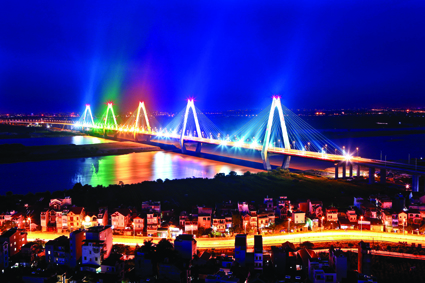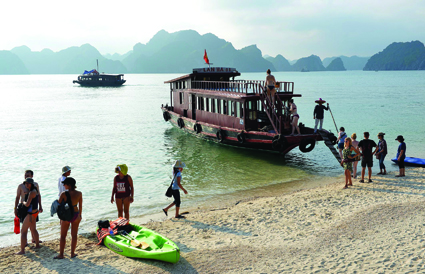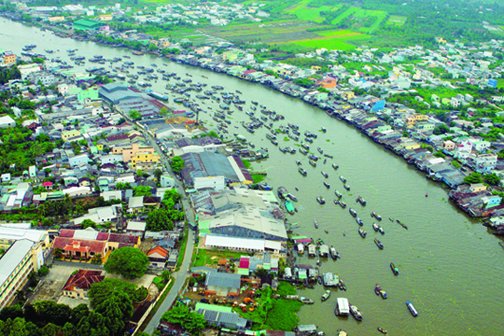Located in the Southeast of the Mekong River delta and lying between two big rivers of Co Chien and Hau, Tra Vinh province has seven rural districts and Tra Vinh city, covering a total area of 2,295.1 square kilometers. The province is 130 kilometers from Ho Chi Minh City and 70 kilometers from Can Tho city, and has sections of national highways 53, 54 and 60 linking it with other Mekong River delta provinces of Ben Tre, Vinh Long and Soc Trang. It has a population of 1.1 million and is home to three ethnic groups with Kinh (Viet) being the most populous, followed by Khmer and Hoa (Sino-Vietnamese).
 |
| Harvesting summer-fall rice crop in Tieu Can district, Tra Vinh province__Photo: Huy Hoang/VNA |
This year, its gross domestic product growth rate is expected to reach 11 percent and its average per-capita income of VND 27.6 million (USD 1,290) (VND 5 million/person higher than 2013). Its economic restructuring has proceeded in a positive manner with improvements seen in education, healthcare and poverty reduction.
The province ranked 13th nationally and 5th in the Mekong River delta in the 2013 Provincial Competitiveness Index. However, its two sub-indices - entry costs and land access, remain the highest throughout the country. Tra Vinh targets a 12-13 percent GDP growth and an average per-capita income of around VND 30.75 million (USD 1,442), and plans to export 250,000 tons of rice, 8,800 tons of frozen shrimps, 20,500 tons of frozen fish, 8,000 tons of Surimi fried fish and 3,200 tons of active charcoal in 2015.
It also looks toward to earning an export turnover of USD 300 million and attaining proportions of agriculture-forestry-fisheries, industry and construction, and services to over 38 percent, 28 percent and 33.87 percent, respectively, in its GDP.
At a three-day meeting of the provincial People’s Council which ended on December 5, Vice Chairman of the provincial People’s Committee Nguyen Thanh Tam said the province had successfully completed 16 out of 20 targets set for 2014 by the Council. The unfulfilled targets include increase in the number of communes, wards and townships building a new countryside, and reduction of birthrate and rate of malnourished under-five children.
Moves to attract FDI
Like other Mekong River delta provinces, Tra Vinh boasts agricultural potential and has advantages in aquaculture and seafood exploitation for processing industry. With a coastline of 65 kilometers, it has made the best use of marine resources to restructure its economy towards higher industrial and service proportions.
To meet the increasing demand for transportation between Tra Vinh and other Mekong River delta provinces, a canal for heavyweight vessels from the sea to Hau river will be completed by the end of 2015. The canal will help boost the export of farm produce with more effective waterway transportation without having to pass through the ports in Ho Chi Minh City and other southeastern provinces and increase the competitiveness and economic efficiency of regional provinces.
In the meantime, the 4,400-megawatt Duyen Hai Power Center is expected to ensure stable power supply for industrial production and make Dinh An economic zone (EZ) particularly appealing to investors.
Tra Vinh is now home to one economic zone and three industrial parks (IPs). Located in the province’s southeastern Tra Cu and Duyen Hai districts, Dinh An EZ covers 39,020 hectares (some 15,403 hectares will be completed in the first phase). The EZ has so far attracted 16 investment projects and is expected to become a key EZ for the development of power generation, petrol-chemical, shipbuilding and supporting industries as well as tourism and services linking to ports, non-tariff areas and residential areas.
Meanwhile, operating Long Duc IP reports land occupancy rate of nearly 100 percent, attracting 26 investment projects worth more than VND 2 trillion (USD 107 million) including 12 foreign direct investment projects capitalized at USD 66 million.
In order to attract investors, Tra Vinh’s administration has provided them support for finding investment locations, building infrastructure, transferring science and technology, and training human resources. Apart from improving its public administration performance index, the province has simplified its administrative procedures in various sectors so that formalities can be fulfilled under the “one-stop-shop” mechanism. Improvements can be seen not only in transportation and power infrastructure but also in the quality of support services such as finance, banking, insurance, hotel, restaurant, office for lease, and entertainment.
Tra Vinh is calling for investment in infrastructure of the 120-hectare Cau Quan IP in Tieu Can district and the 200-hectare Co Chien IP in Cang Long district.
According to the Foreign Investment Agency of the Ministry of Planning and Investment, Tra Vinh has so far this year attracted two FDI projects totaling USD 10.1 million, bringing the total number of FDI projects in the province to 31 with a combined capital of over USD 198.9 million.
As a result, the province now has 138 domestic- and foreign-invested projects worth USD 203.4 million.
In September, Tra Vinh welcomed 11 investors from the Republic of Korea, Japan, China and Singapore to explore investment opportunities. They expressed their interest in wind power development, technical infrastructure, automobile manufacture, material development, fisheries and agricultural machinery and paper production.
To create the best environment for investors, the provincial administration has adopted a number of incentive policies. At present, investment projects in Dinh An EZ and other hi-tech, software production and special infrastructure projects enjoy a corporate income tax rate of 10 percent for 15 years. Meanwhile, investment projects in Cau Quan IP, cattle and fish feed projects and traditional craft development projects are entitled to corporate income tax exemption for two years and 50-percent tax reduction in subsequent four years. Projects engaged in listed sectors eligible for special investment incentives in Cau Quan and Co Chien IPs will be exempted from land rental for 15 and 11 years, respectively.
Tra Vinh needs investment worth some VND 6 trillion in 21 industrial projects, VND 3.7 trillion in seven agricultural projects, VND 65 trillion in 13 urban and infrastructure development projects and VND 2.2 trillion in seven service, trade and tourism projects.
Investments are also needed in the development of material zones applying new processing technologies; agriculture, forestry and fisheries production; ship building and repair industries; and new construction material production.
Tourism potential
Having a favorable geographical location, Tra Vinh boasts rivers, mangrove forests and a rich ecosystem for tourism development. Tra Vinh city is considered a green urban center of the Mekong River delta with thousands of century-old trees. The province is famous for 141 ancient Khmer pagodas and dozens of temples of the Kinh and Hoa people. The province is also well-known for traditional festivals like the Ok Om Bok (moon worship to wish for a prosperous harvest) festival and the Nghinh Ong (Whale Worship) festival.
The most searched-for tourism venues are the Uncle Ho altar site in Long Duc commune (Tra Vinh city), Ba Dong beach and Ba Om Pond site.
However, the number of foreign and domestic tourists visiting the province in the first half of the year remained modest with only 150,000, including 4,800 foreigners.
To attract more tourists to the province, in September Tra Vinh joined Tien Giang, Ben Tre and Vinh Long provinces in organizing a tourism exhibition entitled “Mekong Orchard and Waterway Tourism”. The provincial Tourism Promotion Information Center has introduced tourism potential and tourist zones as well as culture, festivals, policies and the list of tourism projects calling for investment. The list include 84-ha Ba Om cultural and tourist zone that needs an estimated capital of around VND 52 billion (USD 3.25 million) and Ba Dong sea tourism area that needs an investment of VND 207 billion (USD 12.9 million).
In addition, Tra Vinh has invested in infrastructure, ecotourism sites and green tourism in Ba Dong tourist area and isles in Long Tri and Tan Qui, restoration and embellishment of historical and cultural relics. It has also cooperated with other Mekong River delta provinces of Tien Giang, Ben Tre and Vinh Long to open tours to these provinces.- (VLLF)



